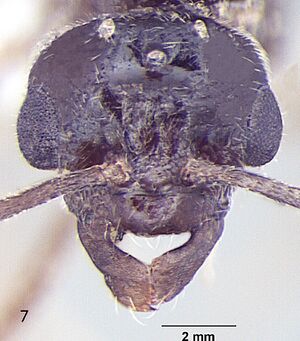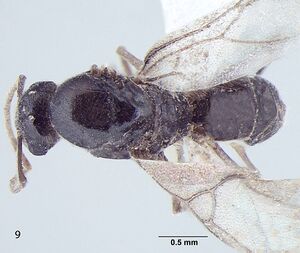Lasius alienoflavus
| Lasius alienoflavus | |
|---|---|

| |
| Scientific classification | |
| Kingdom: | Animalia |
| Phylum: | Arthropoda |
| Class: | Insecta |
| Order: | Hymenoptera |
| Family: | Formicidae |
| Subfamily: | Formicinae |
| Tribe: | Lasiini |
| Genus: | Lasius |
| Section: | flavus clade |
| Species group: | flavus |
| Species: | L. alienoflavus |
| Binomial name | |
| Lasius alienoflavus Bingham, 1903 | |
Collected from forested mountains surrounded by other mountains. Nests were very close to the surface with a depth of 3–5 inches. The soil surrounding the nest was mainly moist and covered by herbs. Twenty-three specimens were collected from Winkler extraction. (Bharti and Gul 2014)
Identification
Wilson (1955) - The three specimens examined are indistinguishable from northern Eurasian Lasius flavus of comparable size except for their longer maxillary palps and the fact that segment VI is longer than segment V. The right maxillary palp of a specimen in the MCZ measured as follows: segment III 0.15 mm., IV 0.11 mm., V 0.08 mm., VI 0.09 mm. flavus workers of the same approximate size have much shorter segments: segment III probably never exceeds 0.13 mm., IV, 0.08 mm., V, 0.06 mm., or VI, 0.06 mm., and these segments are usually distinctly shorter. In this character alienoflavus sctually overlaps the lower limits of the subgenus Lasius: Lasius sitiens workers of comparable size have approximately the same segment proportions.
Keys including this Species
- Key to the Lasius of the Indian Himalayas
- Key to Lasius Palaearctic workers
- Key to Lasius males
- Key to Lasius queens
Distribution
Latitudinal Distribution Pattern
Latitudinal Range: 32.812778° to 32.48611°.
| North Temperate |
North Subtropical |
Tropical | South Subtropical |
South Temperate |
- Source: AntMaps
Distribution based on Regional Taxon Lists
Oriental Region: India (type locality), Nepal, Pakistan.
Distribution based on AntMaps
Distribution based on AntWeb specimens
Check data from AntWeb
Countries Occupied
| Number of countries occupied by this species based on AntWiki Regional Taxon Lists. In general, fewer countries occupied indicates a narrower range, while more countries indicates a more widespread species. |

|
Estimated Abundance
| Relative abundance based on number of AntMaps records per species (this species within the purple bar). Fewer records (to the left) indicates a less abundant/encountered species while more records (to the right) indicates more abundant/encountered species. |

|
Biology
Castes
Worker
  
| |
| . | |
Queen
  
| |
| . | |
Male
  
| |
| . | |
Nomenclature
The following information is derived from Barry Bolton's Online Catalogue of the Ants of the World.
- alienoflavus. Lasius alienoflavus Bingham, 1903: 341 (w.q.) INDIA. Combination in L. (Cautolasius): Wilson, 1955a: 111. See also: Collingwood, 1982: 290.
Unless otherwise noted the text for the remainder of this section is reported from the publication that includes the original description.
Description
Worker
Bharti and Gul (2014) - 0.82–0.91; HW 0.75–0.86; EL 0.12–0.15; EW 0.09–0.12; SL 0.70– 0.80; WL 0.88–1.04; PW 0.20–0.24; GL 0.61–1.05; HS 0.78–0.88; CI 101–109; EI 15– 18; SI 80–88; SI 85–95; nHS+nHHT < 8; TL 2.5–2.8. n = 32.
Head: Head roughly rectangular in full face view (CI = 101–109); posterior margin of head straight; posterolateral corners rounded; a few setae present closer to posterior margin of head but not reaching the hind margin of eyes and less denser than in Lasius elevatus Bharti et Gul, 2013; lateral sides of head more-or-less parallel, somewhat narrowing anteriorly; anterior clypeal margin broadly convex, clypeal carina absent; lateral clypeal profile convex; eyes almost round, size larger as compared to other species of the same group (EI = 15–18); mandibles triangular, the masticatory margin with 7 to 8 teeth, rarely 9, including denticles; antennae 12 segmented, scape long, distinctly surpassing the posterior margin of head (SI = 80–88, SI = 85–95).
Mesosoma and petiole: Mesosoma with weakly convex promesonotal dorsum slightly depressed at the suture; propodeal dome rather hemispheric, as high as mesonotum, posterior slope of propodeum somewhat straight; area between propodeal spiracle and metapleural gland without distinct setae; in frontal view petiole with weakly convex sides and rather straight dorsum, in profile with steep and slightly convex anterior face and straight posterior face; gaster more-or-less ovate.
Sculpture and pilosity: Head and mesosoma with shallow micropunctures; in general body smooth and fairly shiny with scattered pilosity; body covered with suberect to erect setae, abundant and longest on gaster; cuticular surface covered with smooth and rather dense pubescence; genae without standing hairs or setae; scape with subdecumbent to decumbent pubescence, a few setae present at the proximal end; hind tibia pubescence smooth, setae are normally present at the proximal end.
Colour: The species is light to dark yellow in colour; the masticatory margin dark brownish and the eyes black in colour; pubescence pale-yellow.
Queen
Bharti and Gul (2014) - HL 1.12–1.15; HW 1.32–1.37; EL 0.34–0.36; EW 0.26–0.27; SL 1.0– 1.02; WL 2.33–2.45; PW 0.24–0.26; GL 2.30–2.70; HS 1.24–1.26; CI 81–84; EI 25–26; SI 87–89; SI 73–74; TL 5.7–6.3. n = 2.
Resembles the worker, with modifications expected for caste and the following differences: body massive, hairy; lateral sides of head subparallel, narrowing towards the anterior margin; eyes much larger; mesosoma enlarged, dorsally flat, scutum and scutellum at the same level, propodeal declivity very steep; in profile view petiole compressed, in frontal view dorsum emarginate; gaster long and gibbous; setae scattered all over and short; head, mesosoma and gaster dark brown, legs dark yellow in colour.
Male
Bharti and Gul (2014) - HL 0.6; HW 0.7; EL 0.27; EW 0.18; SL 0.48; WL 1.3; PW 0.25; GL 1.7; HS 0.65; CI 86; EI 38; SI 80; SI 68; TL 3.6. n = 1.
Head: Head roughly squarein full face view (CI = 86); Head broader at the posterior margin, narrowingtowards the anterior margin; posterior margin of head slightly convex; posterolateral corners rounded; Hairsdenser towards the posterior margin of head; lateral sides of head distinctly narrowinganteriorily; eyes very large, bulging beyond head outline in full-frontal view (EI = 38); three prominent ocelli present at the centre; antennae 13 segmented, filiform; scape long, distinctly surpassing the posterior margin of head (SI = 80; SI = 68); clypeus smooth, without any carina in the middle; anterior clypeal margin broadly convex; lateral clypeal profile convex; mandiblewith an apical tooth and 3 denticles at the centre of masticatory margin.
Mesosoma and petiole: Mesosomaenlarged to accommodate flight muscles; pronotum small; scutum smooth; scutellum somewhat raised; declivity steep; in frontal view petiole dorsallyround; gaster lengthened, tapering towards the apex. Sculptureand pilosity: Ingeneral body smooth with scattered pilosity; body covered with suberect toerect setae, abundant and longest on gaster; cuticular surface covered with smooth and rather dense pubescence abundant towards the apex of gaster, antennae and legs; Hairs more dense on the posterior margin of head, sparsely distributed over rest of the head; standinghairs or setae on genae sparse; mandibles with a few setae at the apicalportion; a few setae present on the anterior margin of clypeus; small blunthairs thinly present on the eyes; scape with subdecumbent to decumbentpubescence, a few setae present at the proximal end; hind tibia pubescencesmooth, setae are normally present at the proximal end.
Genitals: Paramereselongated, roughly triangular, covered with long setae; cuspi with short peg-like teeth and bent towards digiti; digiti straight and long, about 3 timesas long as cuspi with round dorsum; penis valve projecting.
Colour: brown with a blackish tinge; eyes black; legs and wings creamy-yellowish; body smooth and somewhat shiny all over.
Type Material
Wilson (1955) - I have seen two workers in the American Museum of Natural History and one in the Museum of Comparative Zoology labelled "N. Indien, I. XXXVII (Wroughton) / L. alieno-brunneus var. alieno-flavus For." From Bingham's description and comments it seems certain that these are part of the type nest series, but they were probably sent by Forel directly to Wheeler in the AMNH without first having been examined by Bingham. I do not think therefore it would be a valid procedure to select one as lectotype. The MCZ nidotype gives the following measurements: PW 0.51 mm., HW 0.76 mm., SL 0.70 mm., 81 92, EL 0.13 mm., ommatidium number 36 and 39. A second intercalary tooth is lacking in the one exposed (left) mandible. Petiole feebly emarginate. Cephalic pubescence dilute, as described for the eastern North American population of Lasius flavus. Head shape difficult to judge at this size, apparently intermediate (eastern North American flavus-nearcticus) approaching the Lasius nearcticus form, probably also within the range of variation of the Eurasian flavus. Otherwise identical to flavus. PW of AMNH nidotypes 0.44 and 0.48 mm.
References
- Bharti, H., Gul, I. 2014. First description of the male caste of the Himalayan endemic ant Lasius alienoflavus Bingham, 1903 (Hymenoptera: Formicidae), with re-description of the female and queen castes. Biodiversity Data Journal 2:e1136 (doi:10.3897/BDJ.2.e1136).
- Bingham, C. T. 1903. The fauna of British India, including Ceylon and Burma. Hymenoptera, Vol. II. Ants and Cuckoo-wasps. London: Taylor and Francis, 506 pp. (page 341, worker, queen described)
- Boudinot, B.E., Borowiec, M.L., Prebus, M.M. 2022. Phylogeny, evolution, and classification of the ant genus Lasius, the tribe Lasiini and the subfamily Formicinae (Hymenoptera: Formicidae). Systematic Entomology 47, 113-151 (doi:10.1111/syen.12522).
- Collingwood, C. A. 1982. Himalayan ants of the genus Lasius (Hymenoptera: Formicidae). Syst. Entomol. 7: 283-296 (page 290, see also)
- Dendup, K.C., Dorji, C., Dhadwal, T., Bharti, H., Pfeiffer, M. 2021. A preliminary checklist of ants from Bhutan. Asian Myrmecology 14, e014005 (doi:10.20362/am.014005).
- Rasheed, M.T., Bodlah, I., Fareen, A.G., Wachkoo, A.A., Huang, X., Akbar, S.A. 2019. A checklist of ants (Hymenoptera: Formicidae) in Pakistan. Sociobiology 66(3), 426-439 (doi:10.13102/sociobiology.v66i3.4330).
- Subedi, I.P., Budha, P.B., Bharti, H., Alonso, L. 2020. An updated checklist of Nepalese ants (Hymenoptera, Formicidae). ZooKeys 1006, 99–136 (doi:10.3897/zookeys.1006.58808).
- Wilson, E. O. 1955a. A monographic revision of the ant genus Lasius. Bulletin of the Museum of Comparative Zoology 113: 1-201 (page 111, Combination in L. (Cautolasius))
References based on Global Ant Biodiversity Informatics
- Bharti H., Y. P. Sharma, M. Bharti, and M. Pfeiffer. 2013. Ant species richness, endemicity and functional groups, along an elevational gradient in the Himalayas. Asian Myrmecology 5: 79-101.
- Bharti H., and I. Gul. 2014. First description of the male caste of the Himalayan endemic ant Lasius alienoflavus Bingham, 1903 (Hymenoptera: Formicidae), with re-description of the female and queen castes. Biodiversity Data Journal 2: e1136 doi: 10.3897/BDJ.2.e1136
- Collingwood C. A. 1982. Himalayan ants of the genus Lasius (Hymenoptera: Formicidae). Systematic Entomology 7: 283-296.
- Rasheed M. T., I. Bodlah, A. G. Fareen, A. A. Wachkoo, X. Huang, and S. A. Akbar. 2019. A checklist of ants (Hymenoptera: Formicidae) in Pakistan. Sociobiology 66(3): 426-439.

